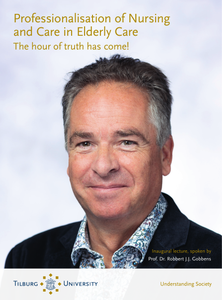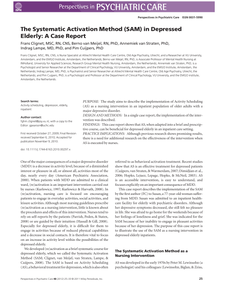Inaugural lecture, delivered upon public acceptance of the endowed professorship in Professionalisation of Nursing and Care in Elderly Care by Prof. Dr. Robbert J.J. Gobbens at Tilburg University on 29 September 2023.
DOCUMENT

Medical imaging practice changed dramatically with the introduction of digital imaging. Although digital imaging has many advantages, it also has made it easier to delete images that are not of diagnostic quality. Mistakes in imaging—from improper patient positioning, patient movement during the examination, and selecting improper equipment—could go undetected when images are deleted. Such an approach would preclude a reject analysis from which valuable lessons could be learned. In the analog days of radiography, saving the rejected films and then analyzing them was common practice among radiographers. In principle, reject analysis can be carried out easier and with better tools (ie, software) in the digital era, provided that rejected images are stored for analysis. Reject analysis and the subsequent lessons learned could reduce the number of repeat images, thus reducing imaging costs and decreasing patient exposure to radiation. The purpose of this study, which was conducted by order of the Dutch Healthcare Inspectorate, was to investigate whether hospitals in the Netherlands store and analyze failed imaging and, if so, to identify the tools used to analyze those images.
DOCUMENT

Home rehabilitation after a hip operation can be daunting for the elderly. Lack of motivation to exercise and being insecure in the recovery process are common barriers. Personalized eHealth can help to ensure that the patient exercise efficiently, filling the gap between treatment in the practice with the physical therapist and practice at home.
DOCUMENT

The study aims to describe the implementation of Activity Scheduling (AS) as a nursing intervention in an inpatient population of older adults with a major depressive disorder. DESIGN AND METHODS: In a single case report, the implementation of the intervention was described. FINDINGS: This case report shows that AS, when adapted into a brief and prescriptive course, can be beneficial for depressed elderly in an inpatient care setting. PRACTICE IMPLICATIONS: Although previous research shows promising results, there is a need for additional research on the effectiveness of the intervention when AS is executed by nurses.
DOCUMENT

BACKGROUND: Depression in later life is a common mental disorder with a prevalence rate of between 3% and 35% for minor depression and approximately 2% for Major Depressive Disorder (MDD). The most common treatment modalities for MDD are antidepressant medication and psychological interventions. Recently, Behavioral Activation (BA) has gained renewed attention as an effective treatment modality in MDD. Although BA is considered an easy accessible intervention for both patients and health care workers (such as nurses), there is no research on the effectiveness of the intervention in inpatient depressed elderly.The aim of study, described in the present proposal, is to examine the effects of BA when executed by nurses in an inpatient population of elderly persons with MDD. METHODS/DESIGN: The study is designed as a multi-center cluster randomized controlled trial. BA, described as The Systematic Activation Method (SAM) will be compared with Treatment as Usual (TAU). We aim to include ten mental health care units in the Netherlands that will each participate as a control unit or an experimental unit. The patients will meet the following criteria: (1) a primary diagnosis of Major Depressive Disorder (MDD) according to the DSM-IV criteria; (2) 60 years or older; (3) able to read and write in Dutch; (4) have consented to participate via the informed consent procedure. Based on an effect size d = 0.7, we intend to include 51 participants per condition (n = 102). The SAM will be implemented within the experimental units as an adjunctive therapy to Treatment As Usual (TAU). All patients will be assessed at baseline, after eight weeks, and after six months. The primary outcome will be the level of depression measured by means of the Beck Depression Inventory (Dutch version). Other assessments will be activity level, mastery, costs, anxiety and quality of life. DISCUSSION: To our knowledge this is the first study to test the effect of Behavioral Activation as a nursing intervention in an inpatient elderly population. This research has been approved by the medical research ethics committee for health-care settings in the Netherlands (No. NL26878.029.09) and is listed in the Dutch Trial Register (NTR No.1809).
DOCUMENT

Introduction Many health care interventions have been developed that aim to improve or maintain the quality of life for frail elderly. A clear overview of these health care interventions for frail elderly and their effects on quality of life is missing. Purpose To provide a systematic overview of the effect of health care interventions on quality of life of frail elderly. Methods A systematic search was conducted in Embase, Medline (OvidSP), Cochrane Central, Cinahl, PsycInfo and Web of Science, up to and including November 2017. Studies describing health care interventions for frail elderly were included if the effect of the intervention on quality of life was described. The effects of the interventions on quality of life were described in an overview of the included studies. Results In total 4,853 potentially relevant articles were screened for relevance, of which 19 intervention studies met the inclusion criteria. The studies were very heterogeneous in the design: measurement of frailty, health care intervention and outcome measurement differ. Health care interventions described were: multidisciplinary treatment, exercise programs, testosterone gel, nurse home visits and acupuncture. Seven of the nineteen intervention studies, describing different health care interventions, reported a statistically significant effect on subdomains of quality of life, two studies reported a statistically significant effect of the intervention on the overall quality of life score. Ten studies reported no statistically significant difference between the intervention and control groups. Conclusion Reported effects of health care interventions on frail elderly persons’ quality of life are inconsistent, with most of the studies reporting no differences between the intervention and control groups. As the number of frail elderly persons in the population will continue to grow, it will be important to continue the search for effective health care interventions. Alignment of studies in design and outcome measurements is needed.
MULTIFILE

Healthcare settings are increasingly adopting nature-based interventions (NBIs) to support users’ health and well-being, but these interventions are often underutilized. To get a grip on utilization problems, insight into factors that affect use and uptake of NBIs in routine care is needed. This scoping review aimed to provide an overview of factors that facilitate or impede successful implementation of NBIs in hospitals, long-term care facilities for the elderly (LTCF), and rehabilitation centers. Systematic searches were conducted across various databases to identify studies that collected qualitative and/or quantitative data on the implementation of NBIs in healthcare settings. Findings were classified into the five domains of the Consolidated Framework for Implementation Research. A total of 57 articles were included in the review. The articles provide detailed insight into facilitating and impeding implementation factors related to the intervention (e.g., awareness, adaptability, type of natural elements, accessibility, safety, weather conditions, comfort, privacy, supportive design factors, activities). Other found factors related to the inner setting (e.g., culture, implementation climate) and individuals (e.g., characteristics and opportunities of stakeholders). Factors related to the outer setting (e.g., financing) and implementation process (e.g., teaming, assessing needs, planning, engaging, doing, integration in care and therapy, reflection and evaluation, maintenance) also emerged, but to a lesser extent. This review identified a broad range of factors important for the successful implementation of NBIs, which can guide implementation of future NBIs. To complement these findings, future studies should consider conducting implementation studies
MULTIFILE

Background: The need for effective continuing education is especially high in in-hospital geriatric care, as older patients have a higher risk of complications, such as falls. It is important that nurses are able to prevent them. However, it remains unknown which interventions change the behavior of nurses. Therefore, the aim of this study is to identify intervention options to change the behavior of hospital nurses regarding fall prevention among older hospitalized patients. Methods: This study used a mixed method design. The Behavior Change Wheel (BCW) was used to identify intervention functions and policy categories to change the behavior of nurses regarding fall prevention. This study followed the eight steps of the BCW and two methods of data collection were used: five focus groups and three Delphi rounds. The focus groups were held with hospital nurses (n = 26). Geriatric experts (n = 11), managers (n = 13) and educators (n = 13) were included in the Delphi rounds. All data were collected within ten tertiary teaching hospitals in the Netherlands. All participants were included based on predefined in- and exclusion criteria and availability. Results: In Geriatric experts’ opinions interventions targeting behavior change of nurses regarding fall prevention should aim at ‘after-care’, ‘estimating fall risk’ and ‘providing information’. However, in nurses’ opinions it should target; ‘providing information’, ‘fall prevention’ and ‘multifactorial fall risk assessment’. Nurses experience a diversity of limitations relating to capability, opportunity and motivation to prevent fall incidents among older patients. Based on these limitations educational experts identified three intervention functions: Incentivisation, modelling and enablement. Managers selected the following policy categories; communication/marketing, regulation and environmental/social planning. Conclusions: The results of this study show there is a discrepancy in opinions of nurses, geriatric experts, managers and educators. Further insight in the role and collaboration of managers, educators and nurses is necessary for the development of education programs strengthening change at the workplace that enable excellence in nursing practice. DOI: https://doi.org/10.1186/s12912-021-00598-z
MULTIFILE

Persuasive design in the context of home rehabilitation of the elder-ly has been applied. Developing various prototypes based on persuasive fea-tures and behavioral changes helps to tune to more personalized solutions and serves as a valuable tool for implementing blended care in the practice.
MULTIFILE

Background: The COVID-19 pandemic has led highly developed healthcare systems to the brink of collapse due to the large numbers of patients being admitted into hospitals. One of the potential prognostic indicators in patients with COVID-19 is frailty. The degree of frailty could be used to assist both the triage into intensive care, and decisions regarding treatment limitations. Our study sought to determine the interaction of frailty and age in elderly COVID-19 ICU patients. Methods: A prospective multicentre study of COVID-19 patients ≥ 70 years admitted to intensive care in 138 ICUs from 28 countries was conducted. The primary endpoint was 30-day mortality. Frailty was assessed using the clinical frailty scale. Additionally, comorbidities, management strategies and treatment limitations were recorded. Results: The study included 1346 patients (28% female) with a median age of 75 years (IQR 72–78, range 70–96), 16.3% were older than 80 years, and 21% of the patients were frail. The overall survival at 30 days was 59% (95% CI 56–62), with 66% (63–69) in fit, 53% (47–61) in vulnerable and 41% (35–47) in frail patients (p < 0.001). In frail patients, there was no difference in 30-day survival between different age categories. Frailty was linked to an increased use of treatment limitations and less use of mechanical ventilation. In a model controlling for age, disease severity, sex, treatment limitations and comorbidities, frailty was independently associated with lower survival. Conclusion: Frailty provides relevant prognostic information in elderly COVID-19 patients in addition to age and comorbidities. Trial registration Clinicaltrials.gov: NCT04321265, registered 19 March 2020.
DOCUMENT